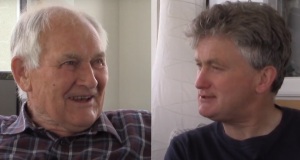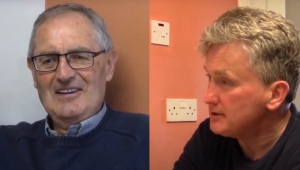Le Gordon Wells

The University of the Highlands and Islands takes inspiration from Island Voices.
Perhaps a surprise to some, but not to us!
Here’s how it all comes back to Benbecula…
The tweeted press release touches on a couple of international projects that are being taken forward by UHI’s Language Sciences Institute. It doesn’t have the space to describe in detail how each builds on experience first gained in the Island Voices/Guthan nan Eilean project, and the closely linked development of Clilstore at Sabhal Mòr Ostaig. Both of these have grown from originally European Union-funded initiatives.
Island Voices followers who have time and inclination to read a bit more may find the additional information below of interest.
“Taisce bheo na nGael/Stòras Beò nan Gàidheal” is a joint Irish/Scottish Gaelic ethnographic retrieval project in which community-based expert speakers are recorded in their own homes. The first stage of the Scottish side of the project was completed shortly before lockdown began. There are now 15 hours of video material with Clilstore transcriptions on the Institute’s website, with access open to all. Project partners are now testing out alternative ways of making recordings online, in case continuing lockdown restrictions mean the Irish recording stage needs to be tackled in a different way.
The same issue has also arisen with the Institute’s “Mediating Multilingualism” project in India, in partnership with Amity University Haryana and the Indian network of Centres for Endangered Languages. With COVID-19 continuing to cause severe disruption to university-based activities there (including fieldwork), the project team has already been trialling the production of home-based recordings for publication on the same, highly flexible, online Clilstore platform. Six Indian languages have been recently added to its linguistic range. Some of these are featured in the short Gaelic film (subtitled in English) “Dà Dhùthaich Iomadh Cànan/Two Lands Many Languages” produced by the UHI team after visiting Shillong in North-East India at the end of 2019 (the International Year of Indigenous Languages). This is also available to view online on the project’s webpage.
Tadhail air Island Voices – Guthan nan Eilean
Powered by WPeMatico

 Happy Birthday to Alasdair Crois Mòraig!
Happy Birthday to Alasdair Crois Mòraig! We continue our exploration of the North Uist cluster in
We continue our exploration of the North Uist cluster in  Angus MacPhail from Clachan in North Uist is another well-known member of the community who kindly agreed to contribute to the
Angus MacPhail from Clachan in North Uist is another well-known member of the community who kindly agreed to contribute to the  Güney Uist adasında bulunan Daliburgh kasabasinda her sene düzenlenen, İskoç Galcesi ve Galik müziği eğitimi veren Ceòlas yaz okulu hakkında kısa bir belgesel.
Güney Uist adasında bulunan Daliburgh kasabasinda her sene düzenlenen, İskoç Galcesi ve Galik müziği eğitimi veren Ceòlas yaz okulu hakkında kısa bir belgesel. Another two-way conversation in the
Another two-way conversation in the 
 Visitors to the annual
Visitors to the annual  In amongst the valuable Gaelic social history,
In amongst the valuable Gaelic social history,